Did you know that it is easy to make your own cottage cheese at home? This low sodium cottage cheese recipe uses ingredients that you probably already have on hand. Learn how to make cottage cheese, including how to make low fat cottage cheese and low salt cottage cheese. Simplify your grocery list by making homemade cheeses and avoid the additives sometimes used in the store-bought versions!
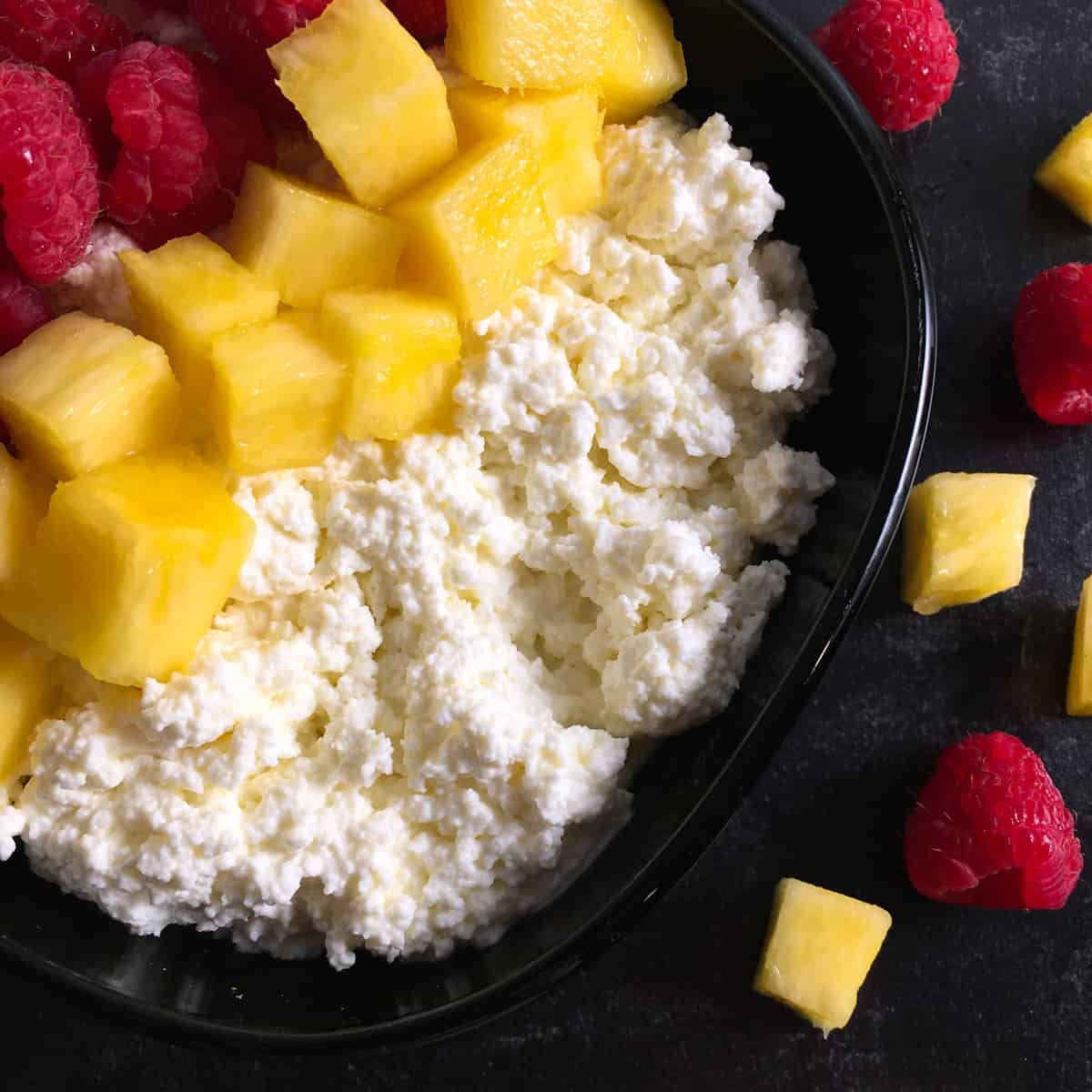
Want to save this post?
Enter your email below and we'll send it straight to your inbox. Plus you'll get great new recipes from us every week!
If you’ve already had success making homemade yogurt, you need to make your own cottage cheese at home. It is so much easier! Additionally, it is versatile; you can use it as a ricotta cheese substitute with a minor tweak to the recipe below.
A big benefit of making your own cottage cheese is that you can make it much lower in sodium than store-bought versions. If you are on a low-sodium diet, you may have noticed that it can be difficult to find low-sodium cottage cheese. Making your own salt free cottage cheese is an easy solution to this problem.
So now you may have some questions:
- Is cottage cheese high sodium?
- How much sodium in cottage cheese?
- Why does cottage cheese have so much sodium?
According to the FDA, 20% or more DV of sodium per serving is considered high in sodium. Many brands of cottage cheese have about 15% DV sodium per serving, so they aren’t technically considered high.
Some of the sodium in cottage cheese is naturally occurring in the milk used to make it. The rest comes from salt added to the cottage cheese. While you can’t control the amount of sodium in milk, you can make homemade cottage cheese salt free.
Table of Contents
- 🥛 Should you use raw milk to make cottage cheese?
- ⭐ Homemade Cottage Cheese Nutrition
- 🥘 Low Sodium Cottage Cheese Ingredients
- 🔪 How to Make Low Sodium Cottage Cheese
- 🤔 How much milk does it take to make a pound of cottage cheese?
- 🧀 How to Make Cultured Cottage Cheese
- 🌡️ Can I freeze cottage cheese?
- 🥣 How to Make Cottage Cheese Taste Good
- 📋 Homemade Cottage Cheese Calories
- FAQs
- 👩🏻🍳 More Cheese Recipes
- 📖 Recipe Card
- 💭 Expert Tips from Dietitian Summer Yule
- 💬 Comments
🥛 Should you use raw milk to make cottage cheese?
A lot of folks who want to know how to make old fashioned cottage cheese ask me if they should use raw milk. Perhaps it is easier to make cultured cottage cheese with raw milk; but my answer is no. Raw milk is NOT needed to make cottage cheese; you can use store-bought pasteurized milk.
The FDA advises choosing pasteurized dairy products to help prevent foodborne illness. Raw dairy products are considered “high risk.” Indeed, there was an outbreak of E. coli O157 in my state several years ago linked to raw milk.
You’ll find conflicting info on this topic online. For example, this recipe by the Kentucky Cooperative Extension Service says “high quality raw skim milk is necessary to make a good cottage cheese…” However, they have you pasteurizing the raw milk before making cottage cheese.
If you want to try a recipe to make your own cottage cheese at home, do it the safe way. Use pasteurized milk from the store.
⭐ Homemade Cottage Cheese Nutrition
Aside from simplifying your grocery list, there are other benefits to making low salt cottage cheese a regular addition in your life. For example, this recipe has no additives that you may find in store-bought cottage cheese.
Store cottage cheese often contains stabilizers, thickeners, and preservatives like carrageenan, locust bean gum, guar gum, and potassium sorbate. You don’t need any of that stuff in there. Here are some more nutritional benefits of making your own cottage cheese:
- Low sodium cottage cheese: According to the FDA, low sodium means the food has 5% or less DV sodium per serving. You can make this cottage cheese low sodium by skipping the added salt.
- Keto cottage cheese: Use this low sugar milk to make very low carb cottage cheese. Cottage cheese is also a naturally gluten free food.
- High quality protein: Cottage cheese is rich in the dairy protein casein. One half cup cottage cheese typically has more protein than the same volume of milk since the protein is concentrated after the liquid is drained off.
- Vitamins and minerals: Cottage cheese is rich in an assortment of essential nutrients, including calcium, phosphorus, vitamin B12, and vitamin A.
- Low sodium cottage cheese for baby: You should keep things simple for a baby just starting solids. This cottage cheese is a better option for baby because it has no added salt.
- Low fat cottage cheese: Make lower fat cottage cheese (i.e., lower saturated fat) by using low fat milk and skipping the cream. For a higher fat recipe, use whole milk and heavy cream. Both have delicious results!
🥘 Low Sodium Cottage Cheese Ingredients
Here’s what you need to make DIY cottage cheese:
- 2 liters milk
- 6 tablespoons white vinegar or fresh lemon juice
- 6 tablespoons heavy cream
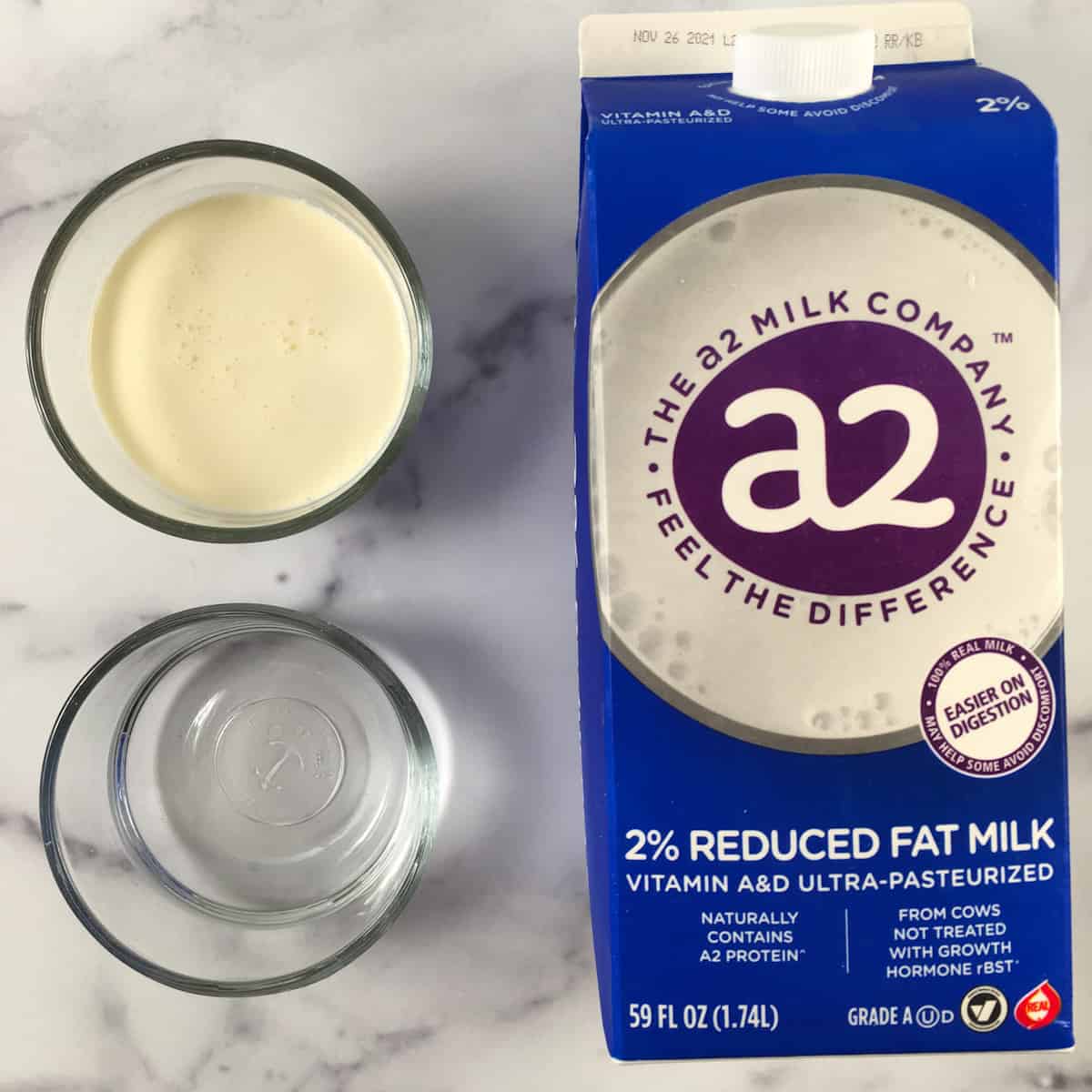
You’re welcome to add a pinch of salt or make no salt added cottage cheese. You can also modify this recipe to make low fat cottage cheese or whole milk cottage cheese. I’ve tried nonfat milk, reduced-fat milk (2% and 1% milk), and whole milk and they all work in this recipe.
The yield of this recipe may vary depending on whether you make it lower or higher in fat. One-half gallon of skim milk yielded about 2.5 unpacked cups of cottage cheese. One-half gallon of 2% milk got me about three unpacked cups of cheese.
Low fat milk gets you “drier” milk curds that suck up more cream when it’s added at the end. Use yogurt or more milk instead of cream to make it creamy for a lower fat version.
Lactose-free milk and A2 milk can be made into cottage cheese without problems. UHT milk or ultra-pasteurized milk may not work in this recipe. Most plant milks contain little protein and cannot be used to make cottage cheese.
Here are some other milks readers have told me work in this recipe (I’ve not tried them yet):
- Goat milk
- Sheep milk
- Half and half
- Powdered milk (with water added)
- Soy milk
Can you make cottage cheese from yogurt? You can make yogurt cheese or kefir cheese by draining the whey, but the texture won’t be like cottage cheese.
Is cottage cheese made out of rotten milk? You can technically make cottage cheese out of sour milk or curdled milk. However, I don’t recommend it for food safety reasons. That said, cottage cheese is a great way to use up extra milk BEFORE it spoils.
🍽 Equipment
This cottage cheese is one of the easiest cheeses to make. You don’t even need a cheese press! Here’s the kitchen equipment you need to make cottage cheese:
- Large pot
- Colander
- Candy thermometer
- Cheesecloth
This is the BEST cheesecloth for making cottage cheese. It is washable and reusable and lasts forever! Forget that flimsy one-use stuff from the grocery store!
🔪 How to Make Low Sodium Cottage Cheese
Time to answer the big question: how does milk turn into cottage cheese?
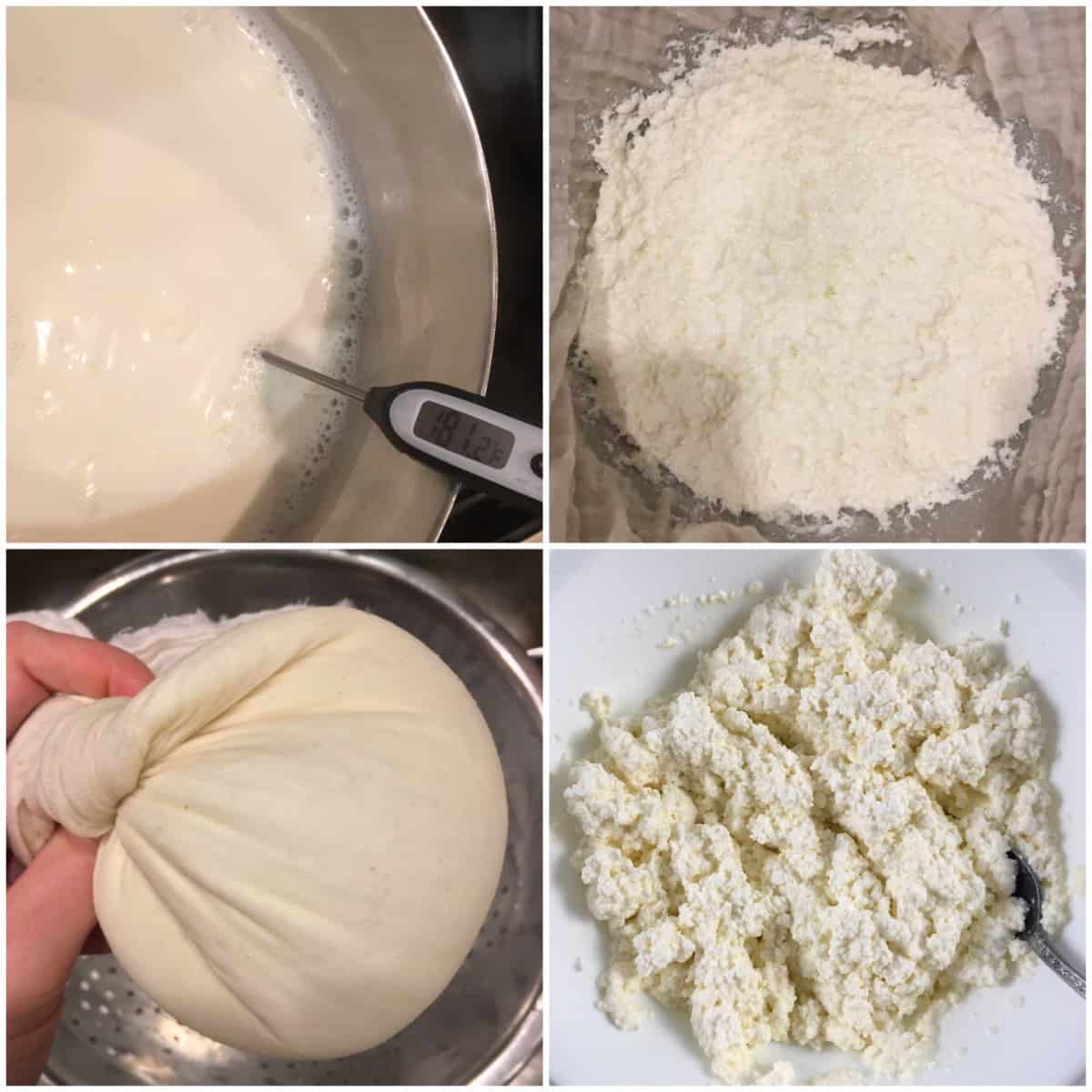
Pour the milk into a pot and bring the milk to 180°F (82°C) over medium heat while whisking frequently. Use a candy thermometer to ensure that you are getting the right temperature.
Once it reaches 180°F (82°C), take the milk off of the heat and stir the vinegar in right away. You should begin to see the yellowish whey separating from the curds immediately. (Yes, the liquid in cottage cheese is whey, FYI.)
Allow the curds and whey to cool at room temperature for approximately 30 minutes.
Line a colander with a double-layer of cheesecloth. Put the colander in the sink or a large bowl. Pour the curds and whey into the lined colander. Let drain for 5 minutes.
The curds will stay in the cloth while the whey will drain away. I typically discard the whey since it tastes and smells strongly of vinegar. You’re welcome to use it in other recipes, if you prefer.
Gather up the edges of the cheesecloth so that the curds are collected into a tight ball. With clean hands, squeeze the ball gently over the sink to release more whey. If you are concerned about a vinegar taste remaining, you can run the ball under gently running water and squeeze again, if desired.
Unwrap the cheesecloth. You can use this cheese as a low sodium ricotta cheese substitute. Yes, this recipe can be used as ricotta or cottage cheese!
Otherwise, put the cheese ball in a bowl and gently break up the curds with a fork. Stir in the heavy cream. You will find that the curds readily absorb the cream, so the finished cottage cheese does not contain much liquid.
Refrigerate before serving, and enjoy!
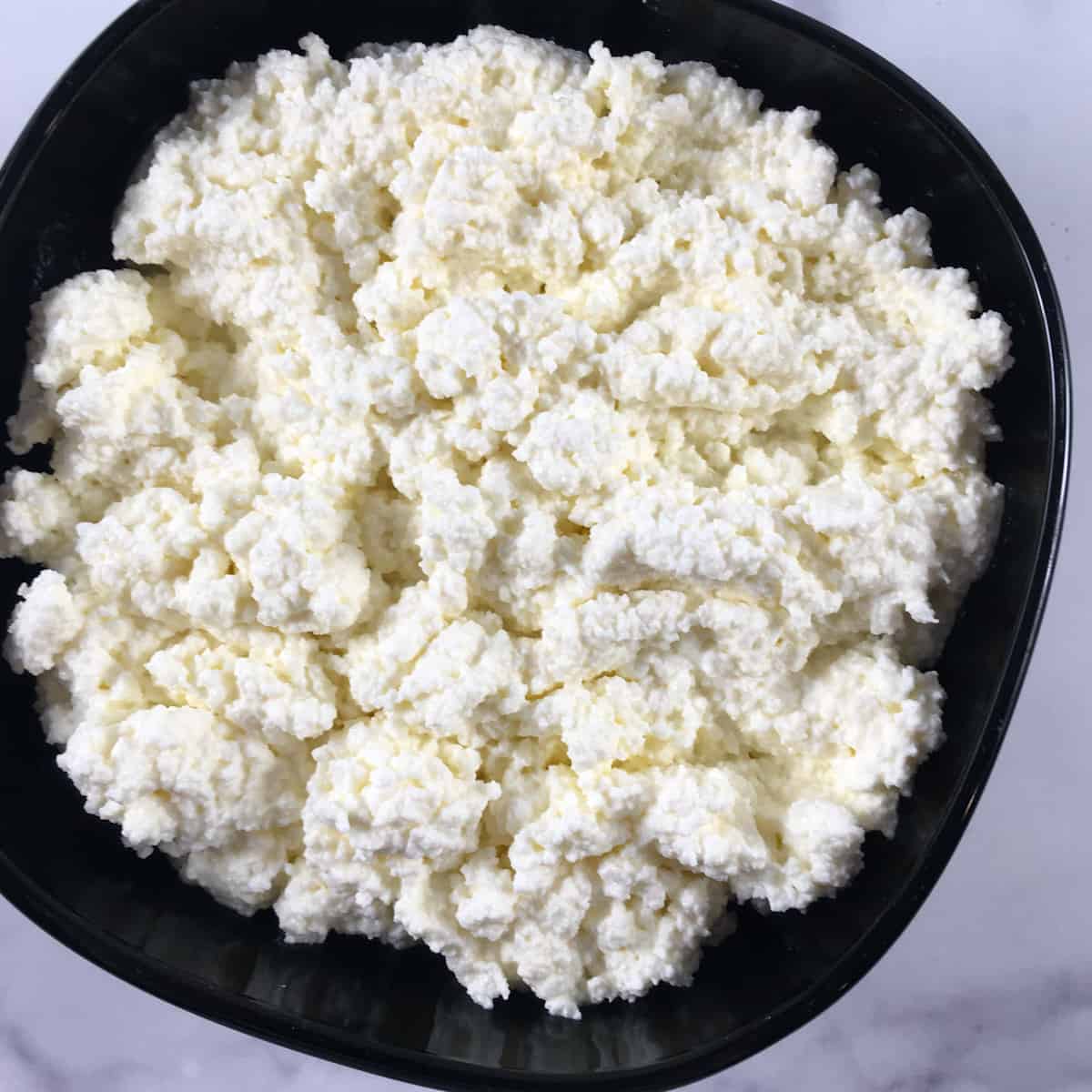
🤔 How much milk does it take to make a pound of cottage cheese?
If you use 2% cow’s milk, you should get about ½ lb. of cheese from this recipe (227g). Thus, 4 liters of milk will make about a pound of cottage cheese. Yields tend to be lower if you use sheep’s milk.
Your yield will also vary depending on how well you drain and squeeze out your curds. You could end up with less or more cheese than me depending on how thoroughly you express the whey.
The curds absorb the cream that is added at the end of the recipe. As you may notice in the photos, the end product is not liquid-y at all.
This may come as no surprise, but the skim milk curds absorbed more cream than the low-fat milk curds. I used about ½ cup of cream with the skim curds and 6 tablespoons of cream with the 2% curds. Depending on the amount of cream added at the end, starting with skim milk may not result in a lower calorie cheese.
🧀 How to Make Cultured Cottage Cheese
The recipe for cottage cheese that I am sharing today is easier than making cultured cottage cheese. The downside here is that you aren’t getting a cottage cheese with live cultures. Some cottage cheeses may contain beneficial live, active cultures, similar to the probiotics found in yogurt.
To make cultured cottage cheese, you can use either buttermilk or sour cream, as long as they contain “live, active cultures.” Instead of vinegar, the sour cream or buttermilk provides some acidity to separate the curd from the whey.
You would add these ingredients to heated then cooled milk and let it sit for several hours. (This prevents the heat from destroying the beneficial bacteria.) The result would (hopefully!) be probiotic-packed cottage cheese.
Unfortunately, I’ve tried recipes using this method and could never get them to work. The results after the curd-setting time always look exactly like the milk I started with. Since the milk sits in the food temperature “danger zone” for many hours, it must be thrown out.
🌡️ Can I freeze cottage cheese?
Yes, this cottage cheese freezes well! Place it in a covered food-safe container in the freezer, and let defrost in the fridge before enjoying.
Does cottage cheese go bad? Yes, cottage cheese can spoil, so make sure to keep it in the fridge. Any homemade cottage cheese that you won’t use in 3-4 days should be frozen.
🥣 How to Make Cottage Cheese Taste Good
I LOVE cottage cheese, and one of my favorite ways to enjoy cottage cheese is with fresh fruit. Give me a bowl of this low salt cottage cheese with pineapple and fresh berries and I am in heaven. It’s great for breakfast or as a healthy dessert.
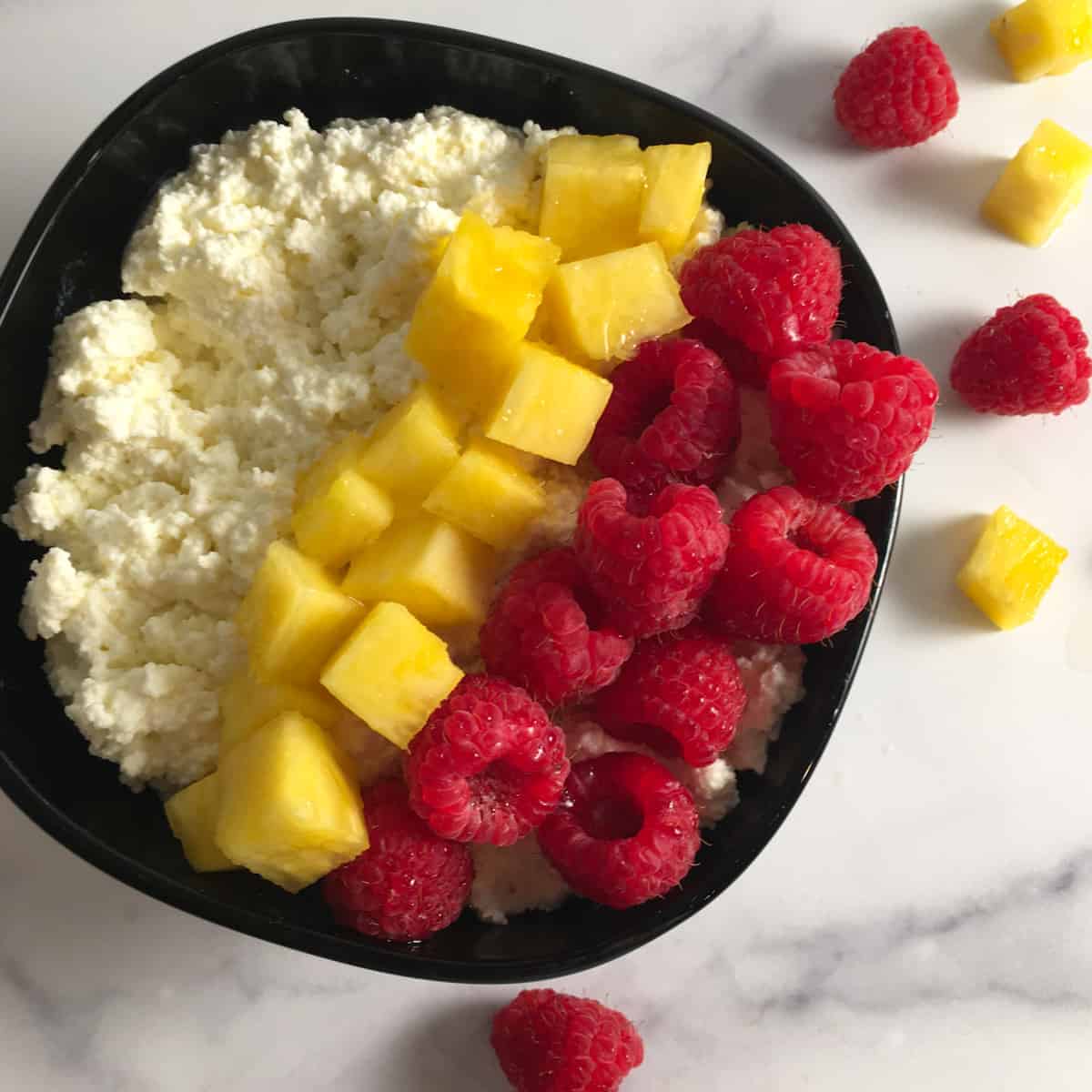
You could also use cottage cheese to top air fryer waffles or as a toast topping. Feel free to make it sweet with maple syrup, honey, or fruit.
I’ve also used this cottage cheese in lasagna as a substitute for ricotta. And it’s great in pierogies in place of farmer’s cheese. (When I use it in savory dishes in place of ricotta, I skip the cream in the recipe.)
You can also use cottage cheese to stuff a Mediterranean omelet, along with tomatoes, onions, and fresh herbs. I’m getting hungry just thinking about it!
📋 Homemade Cottage Cheese Calories
One serving of this low sodium cottage cheese recipe has 158 calories, 12 grams net carbs, 118.8 mg sodium, and 8 grams protein. This is for cottage cheese made with 2% milk and whipping cream. Some nutrition values may be an overestimate as the discarded whey has been included in this information.
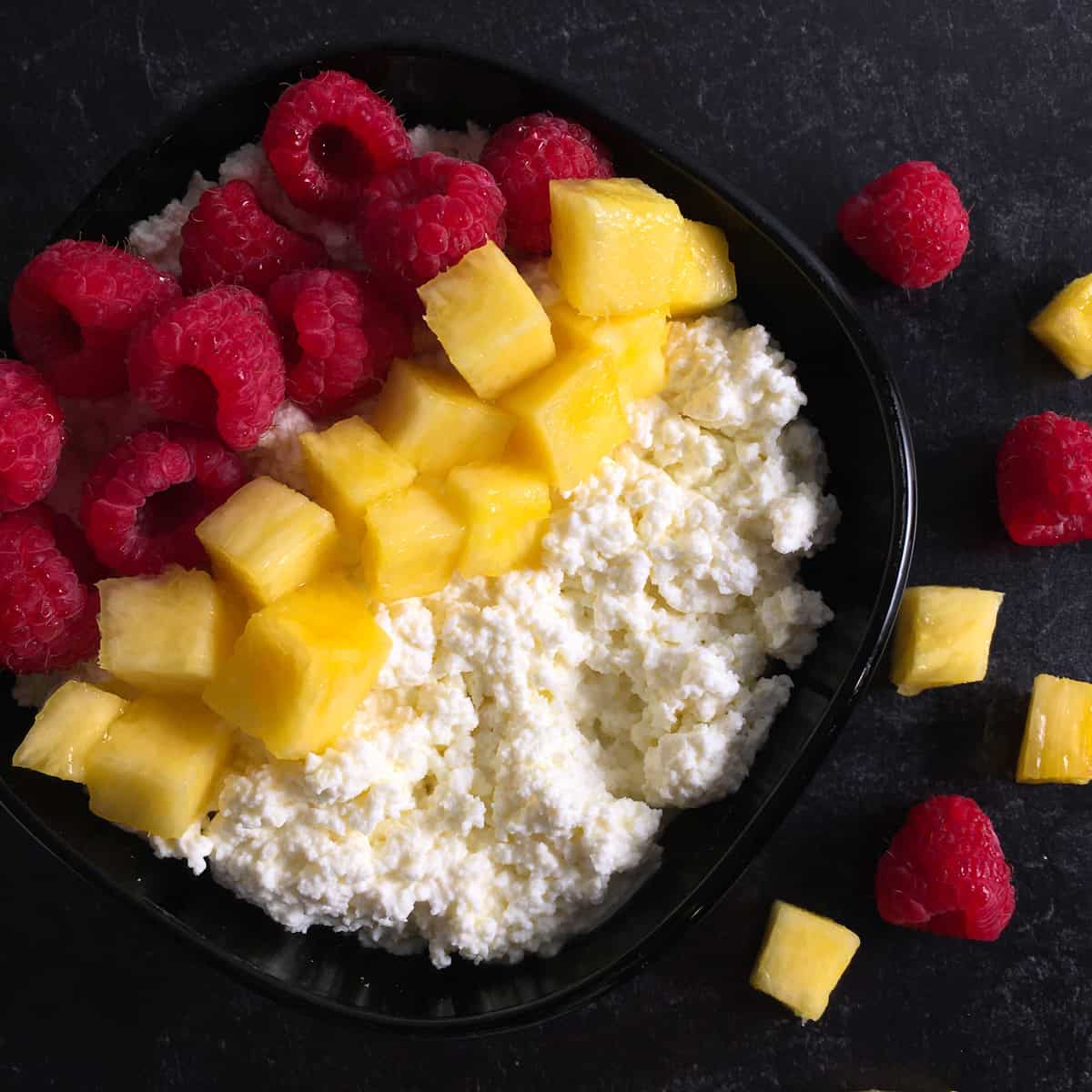
FAQs
How to make cottage cheese with rennet?
Instead of using vinegar, you can set the curds in the cottage cheese with a few drops of rennet. You can get rennet here on Amazon. Keep in mind that rennet is made from the stomach of animals, so your finished cottage cheese won’t be vegetarian.
How to make large curd cottage cheese?
For cottage cheese with large curds, simply cut or mash the curds into bigger pieces after coagulation and draining. For small curd cottage cheese, mash the curds up well with a fork, as I did in this cottage cheese recipe.
Cottage cheese vs ricotta: what’s the difference?
Ricotta is made from the whey leftover in cheesemaking, so the ricotta substitute I’m providing here is not real ricotta. Cottage cheese, on the other hand, is made in a manner similar to paneer. We coagulate the casein protein and discard the whey for cottage cheese.
What are some low sodium cottage cheese brands?
Lucerne cottage cheese (no salt added) is a popular low salt cottage cheese. Also look for Friendship Dairies no salt added cottage cheese, and Prairie Farms 50% less sodium cottage cheese. Breakstone’s lowfat small curd cottage cheese is not no salt, but is lower sodium than many options.
Where can I buy low sodium cottage cheese?
Low sodium cottage cheese from the store can be hard to find! Readers report finding it at Walmart, Stop and Shop, and Kroger. I recommend calling your local grocery stores (like Trader Joe’s) to see if they carry it.
Can you make cottage cheese from almond milk?
No, almond milk is typically too low in protein to make cottage cheese. However, you may be able to make cottage cheese with the protein almond milk brands. (It would be a worthy experiment!)
👩🏻🍳 More Cheese Recipes
Fan of cheese? (Who isn’t, am I right? Haha) Here are a few more recipes using cheese you may enjoy:
📖 Recipe Card
Watch How to Make It!
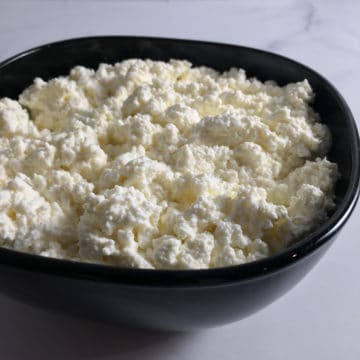
Low Sodium Cottage Cheese (Low Salt Homemade Recipe)
Ingredients
- 2 liters milk
- 6 tablespoons white vinegar (fresh lemon juice may also be used)
- 6 tablespoons heavy cream
Instructions
- On the stovetop, bring the milk to 180°F (82°C) over medium heat while whisking occasionally. Use a candy thermometer to ensure that you are getting the right temperature.
- Once it reaches 180°F (82°C), take the milk off of the heat and stir in the vinegar right away. You should begin to see the yellowish whey separating from the curds immediately.
- Allow the curds and whey to cool at room temperature for approximately 30 minutes.
- Line a colander with a double-layer of cheesecloth. Put the colander in the sink or a large bowl. Pour the curds and whey into the lined colander. Let drain for 5 minutes. The curds will stay in the cloth while the whey will drain away. (The whey can be discarded or saved to be used in another recipe.)
- Gather up the edges of the cheesecloth so that the curds are collected into a tight ball. With clean hands, squeeze the ball gently over the sink to release more whey. If you are concerned about a vinegar taste remaining, you can run the ball under gently running water and squeeze again, if desired.
- Unwrap the cheesecloth. You can use the cheese before you as a ricotta substitute in your recipes. If you want cottage cheese instead, continue on...
- Put the cheese ball in a bowl and gently break up the curds with a fork. Stir in the heavy cream. You will find that the curds readily absorb the cream, so the finished cottage cheese does not contain much liquid.
- If you used 2% milk, this recipe makes approximately three cups of loosely packed cottage cheese. Refrigerate and enjoy!
Notes
💭 Expert Tips from Dietitian Summer Yule
This is a level 1 recipe (may help support fat loss). Why is cottage cheese considered a good “diet food”? Cottage cheese is an excellent choice for a snack or as part of a meal if you desire weight loss. According to Cronometer, ½-cup of 2% cottage cheese provides 12 grams of filling protein for only 92 calories. My favorite way to enjoy cottage cheese is with fruits such as pineapple, blueberries, or strawberries. If you are trying to reduce your calorie intake, keep in mind that one tablespoon of heavy cream provides 50 calories. Adding a few extra glugs of cream into your cottage cheese can easily mean a few hundred additional calories. Unlike milk, heavy cream should be thought of as an added fat, similar to butter. Though cream is fine (and delicious!) to use in moderation, it’s not the best choice if you are looking to lower your saturated fat intake. For low calorie cottage cheese, stir milk or yogurt into the cottage cheese at the end instead of cream. This swap will also give you a low fat cottage cheese if you use lowfat or nonfat dairy. Which is healthier, ricotta or cottage cheese? “Healthy” always depends on what your needs are. In this recipe, the ricotta (cheese without added cream) is the better option for lower calories and saturated fat. If you need a high calorie cheese or want weight gain, cottage cheese with cream is a better choice. Nutrition information is for one serving. This is for cottage cheese made with 2% milk and heavy whipping cream. Some nutrition values (such as carbs) may be an overestimate as the discarded liquid has been included in this information.
nutrition info disclaimer
All recipes on this website may or may not be appropriate for you, depending on your medical needs and personal preferences. Consult with a registered dietitian or your physician if you need help determining the dietary pattern that may be best for you.
The nutrition information is an estimate provided as a courtesy. It will differ depending on the specific brands and ingredients that you use. Calorie information on food labels may be inaccurate, so please don't sweat the numbers too much.
"To taste" means to your preferences, which may have to be visual to follow food safety rules. Please don't eat undercooked food x
Nutrition
Join our community! Subscribe for all of the latest and greatest recipes, and follow me on Facebook, Pinterest, Instagram, and YouTube!

Hello! I'm Summer, a registered dietitian and home chef who loves to cook, eat, and create high quality content for you! Every recipe on this site has been tested by me to help ensure your success in the kitchen. All eaters are welcome here 🙂


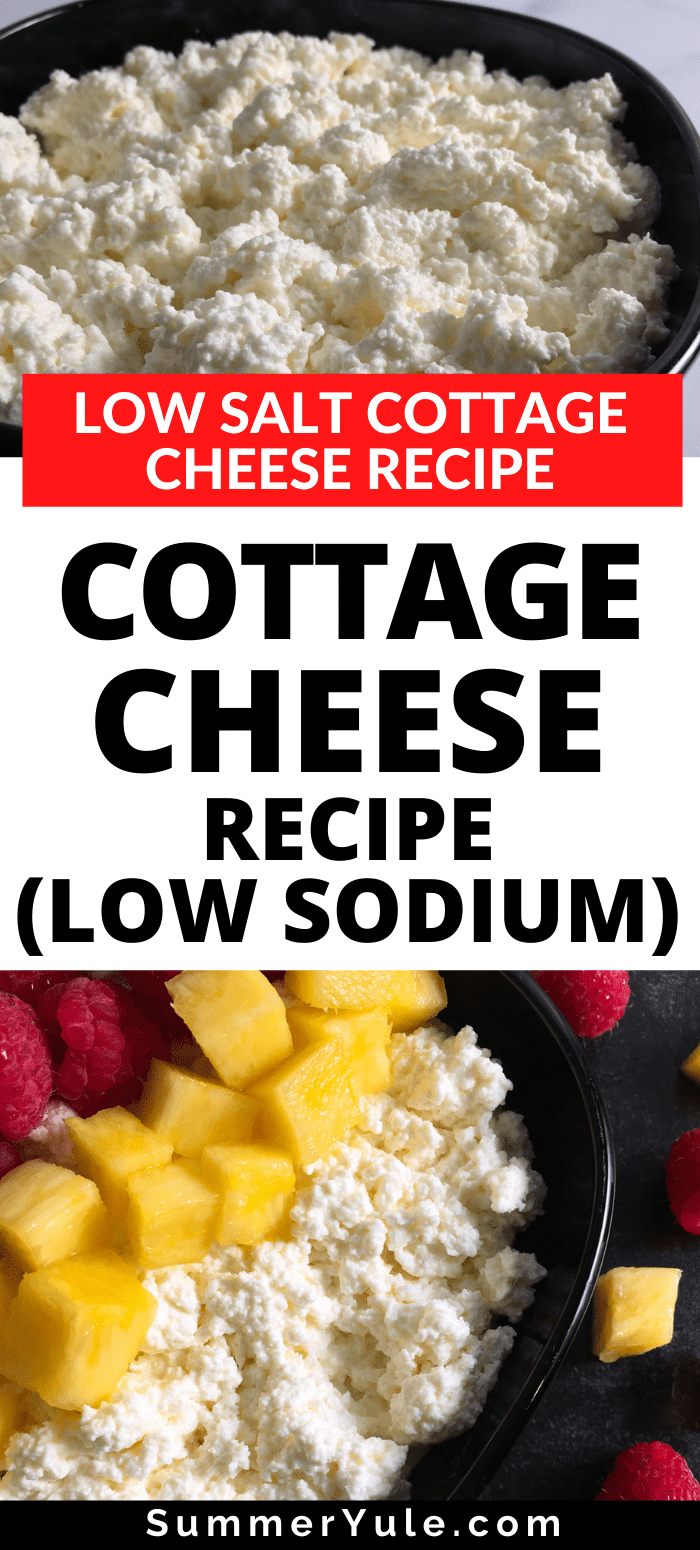
Robyn H. says
I just made this today (09/18/22) and was thrilled with the results. I followed the instructions using lemon juice instead of vinegar and got about 2+ cups of dry curds. I did add 1/2 teaspoon salt but may leave it out next time. I will also use just 1/2 gallon of 2% milk (1.89 liters) instead of measuring out exactly 2 liters & having leftover milk. Or possibly pouring the extra volume in the pan & increasing the lemon juice accordingly. 😉 Because of a gas stove, I was also extra careful warming the milk to avoid scalding it on the bottom of my pan. Thanks for this super simple recipe. 👍🏼 It will get plenty of use.
Summer Yule says
Hi Robyn, thank you for the detailed review! I'm so happy you enjoyed it, and will make it regularly 🙂
Becky says
I'd want to make your low sodium cottage cheese with 1 gallon of 1% milk how much vinegar should I use? Our family is excited to make this!
Summer Yule says
Hi Becky! For a gallon of milk, I would just double the recipe. In other words, use 12 tablespoons of vinegar (3/4 cup). Enjoy!
Becky says
Hi Summer! Thanks for your help. I had one more question I used a gallon of 1% milk and that equals 2000mg of sodium. After I cooked it added the vinegar and put it in cheesecloth in the colander rinsed it and squeezed it out do you know how much sodium is left in the cottage cheese now. Or a percentage guess of how much sodium is removed? Definitely doesn't have to be an exact amount I'm just wondering so I can help my senior mother who has high blood pressure watch her sodium intake. Oh also if you wanted to know this made about 7 servings half cup each. Thank you again so much for this our family is very happy! 😊
Summer Yule says
Hi Becky, great question! After you squeeze it out, you essentially have paneer. This is definitely an estimate, but paneer is about 30.9 mg of sodium per ounce. (Info sourced from Cronometer, entry for "Paneer Cheese, Indian Cheese, data source: NCCDB"... just in case you wanted to know where I pulled the number from 🙂 ) Hope that helps! Summer
Diener Haus says
2 litres is just slightly less than 1/2 gallon. 59 oz. as opposed to 64. 12 tbs of vinegar may be over kill.
Summer Yule says
Hi Diener, I should clarify that I'm assuming US customary measurements. 2 liters = 68 US fl oz or 70 Imperial fluid ounces. More importantly perhaps than these details, I've tried this recipe with double vinegar using a USCS gallon of milk and it works!